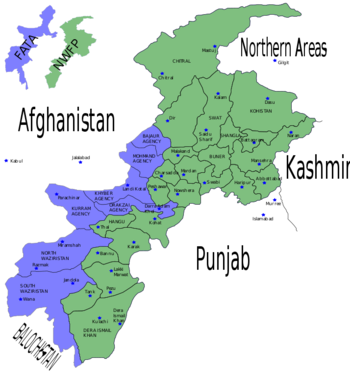Federally Administered Tribal Areas: Difference between revisions
imported>George Swan (subpages) |
imported>Howard C. Berkowitz No edit summary |
||
| Line 9: | Line 9: | ||
| date=2002-12-26 | | date=2002-12-26 | ||
| accessdate=2009-02-11 | | accessdate=2009-02-11 | ||
}} | }} | ||
</ref> | </ref> These are also officially called the '''Federally Administered Tribal Areas (FATA)''', making the distinction that they are outside the regular Pakistani provincial system. | ||
Most of the population of the seven Tribal agencies are traditional, conservative muslims. | Most of the population of the seven Tribal agencies are traditional, conservative muslims. | ||
The agencies are: | The agencies are: | ||
Revision as of 16:47, 17 February 2009
Along Pakistan's border with Afghanistan Pakistan exercises a measure of authority over Pakistan's Tribal Agencies.[1] These are also officially called the Federally Administered Tribal Areas (FATA), making the distinction that they are outside the regular Pakistani provincial system.
Most of the population of the seven Tribal agencies are traditional, conservative muslims. The agencies are: the Bajaur Agency, the Mohmand Agency, the Khyber Agency, the Orakzai Agency, the Kurram Agency and North Waziristan and South Waziristan.
Most of the tribes in the Tribal Agencies are Pashtun -- the same ethnic group that was the Taliban's power base in Afghanistan.[1] It is widely speculated that Osama bin Laden escaped Afghanistan at a border crossing into one of the Tribal Agencies.
References
- ↑ 1.0 1.1 David Rodhe. PAKISTAN TRIBAL REGION; An Anti-U.S. Haven for Al Qaeda, New York Times, 2002-12-26. Retrieved on 2009-02-11.
